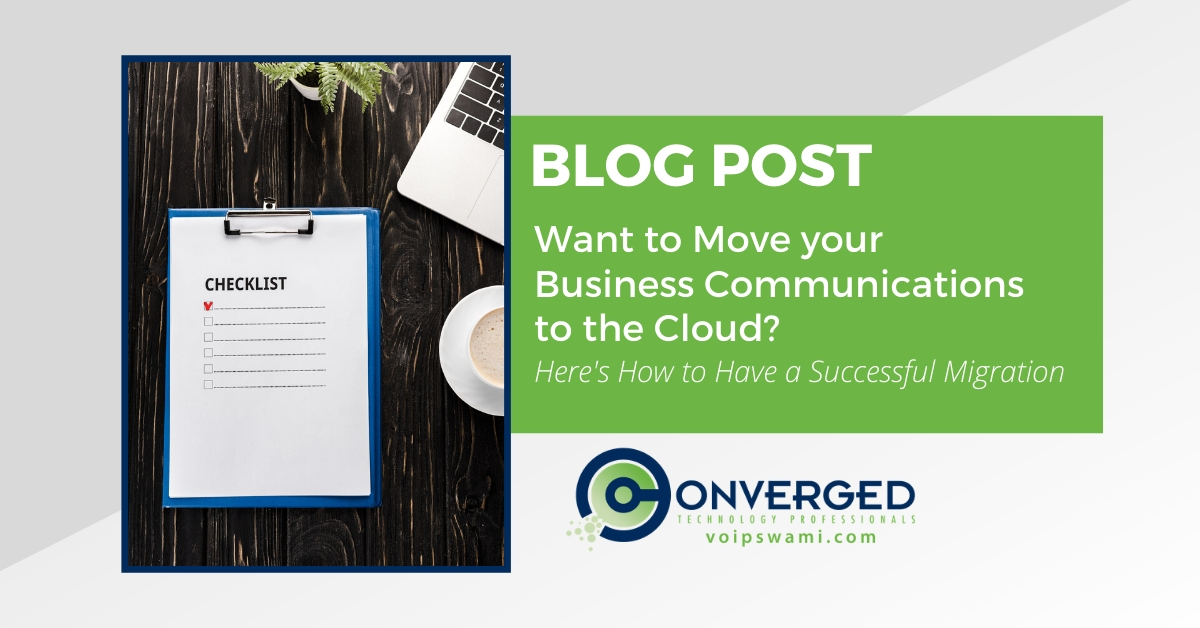
Enjoy this down-to-earth practical migration guide and checklist to understand what’s really involved when moving your business phones to the cloud. Migrating your phones away from your trusted onsite PBX is an implementation project
ripe with errors, stressful moments and lots of aggravation… IF you’re unprepared.
This article will address the various stages of the migration and planning process all the way through implementation so you can plan accordingly and be confident every step of the way.
------------------------------
More Businesses Are Moving their Phone Communications to Cloud
Cloud computing has gone beyond novelty stage and is now a robust, mature platform for business services of all kinds. Most businesses are on the cloud now, and many companies have developed a multi-cloud environment to provide additional redundancy and
reliability.
The exception is found in those who have held out against inevitable change, clinging to old technologies and resisting the migration of services from local data centers and equipment closets to an internet-based environment.
But you can only buck trends for so long. Sooner or later, every business will move all or part of their communications to the cloud -- and that includes telephone services.
Legacy Equipment will Eventually Become Obsolete
We all know the old saying “If it ain’t broke, don’t fix it.” But in an ever-evolving business technology market, you can’t afford to continually rely on deficient, obsolete legacy equipment if you want to compete with others
in your space.
If you don’t want to be left behind, at some point you’ll have to face the facts.
Cloud-based phone systems offer significant improvements in efficiency, flexibility, reliability, and cost savings over traditional local PBX systems. There’s no getting around it.
Another old saying, “All good things must come to an end” also rings true. No matter how well your current local PBX has served you, there will come a time when it will no longer be supported.
PBX vendors of all stripes have recognized this reality and are moving to cloud-based solutions themselves. The unique partnership between Avaya and RingCentral to OEM their cloud platform can't make the point more clearly.
Fewer Upgrades Being Performed on PBX Systems
You may find that your PBX upgrades are becoming less frequent, and your support less helpful.
Many of us look with fondness on the equipment that we “grew up with” in the business. But unfortunately (or not), eventually all legacy solutions reach the end of their life-cycle and find themselves unceremoniously transported to the trash
heap of comm system history.
Why should existing phone system providers continue to put the majority of their R&D into systems that businesses are moving away from?
Leaders such as Mitel, Cisco, and now Avaya, are focusing much of their efforts on the future of cloud. They are offering more options to fill the gap with hybrid alternatives for access to cloud-based communication features and options not
available for legacy PBX users.
This is especially true in the contact center space with
the move away from multi-channel functionality into omni-channel technologies.
Out with the Old, In with the New
Getting rid of old systems can be a bit emotional -- like the loss of an old friend. But discovering the customization and programming options of new cloud-based systems may help you to get over it.
And even though you give up some control by entrusting your PBX to cloud service providers, you will be delighted by all the possibilities available to each phone user to configure their own features or add new ones.

First Step in Cloud Migration Planning - Determine Roles

Once you finally decide to move your phone system to the cloud and who your cloud provider will be, you will need to come up with a plan.
If you are still uncertain about choosing a phone provider, let us know and we'll be glad to help you out in this area by providing a free demo and pricing.
You’ll have to figure out what needs to be done and who needs to do it.
Delegating parts of the project to trusted individuals in your organization means that you’ll have people who can delve deeply into the details of your plan and deal with issues that you hadn’t considered in your initial meetings.
Assigning roles is an important part of any project.
Here are some recommended roles. Not all of these roles are required. Keep in mind if you are working with a support partner such as Converged, some of these roles may be handled directly by them or the phone vendor.
IT Expert/Leader
An IT expert is essential to the whole process of migrating your local PBX to the cloud.
There will still be networking and IT tasks to be completed for a smooth transition. One important requirement for any change to a live system or network is a change management plan.
Working with the cloud service provider and others within the organization, the experienced IT professional should develop a clear Method of Procedure style document to guide every step of the migration.
And there are tasks such as capacity planning, internet connectivity, wi-fi, headsets, and other miscellaneous issues that require the technical know-how of an IT expert.
If you don’t have an IT professional in-house or need additional help, you may want to hire external IT support just
for this project.
Company Managers
Company managers will need to direct and supervise the move.
Of primary importance is the need to make sure that any technical changes are closely aligned with business goals and policies.
- What does the company really need in a cloud-based phone solution?
- What features or services are they looking for?
- How does all this fit into company and departmental budgets?
Project Manager
A project manager gets into all the nitty-gritty of the coordination of tasks and resources. And there are plenty of logistics to coordinate.
There are meetings with all parties, documents requiring signatures, time schedules for activities, allocation of resources, and other assistance where needed. A project manager holds everything together and keeps communication channels open from
start to finish of the project between internal and external points of contacts.
Initial Training for Early Adopters
Initial training on new equipment and software is important, particularly for early adopters of the technology.
During the startup of a cloud-based phone system, you will need to designate
personnel to show new users at least the basics of how to use it, along with documentation that will answer any questions that they may have.
Once the new phone solution is rolled out, there will be undoubtedly some issues that users can’t solve themselves. You’ll need to have some technical support available,
either on-site, by phone, or online, to address any problems that may arise.
Project Planning and Design

Despite any assurances from well-meaning cloud phone service vendors, there is not a “one-size-fits-all” solution for your telephony needs. Every business is different, with its own IT infrastructure and usage requirements.
Project planners will need to develop a comprehensive design that accounts for existing and future network infrastructure, the physical campus environment, and the business functions that the system will support.
This cannot be stated enough especially with larger businesses and those that utilize contact center environments.
A project plan and design should account for all the variations in your IT environment -- beyond the simple desk phone.
Understand your various needs per space and user type
- A conference room, for instance, requires special consideration. Conference room phones are specially made for the purpose. They will need sufficient audio so that everyone can hear. And they will need to be integrated with other network
connectivity and devices present.
- Analog devices such as fax machines will need to interface with the cloud.
- Public area phones may need special configuration that is different from lines that employees use.
- Contact center agents may not need any deskphones at all if they can use softphone applications installed on their computers.
Document all Network Changes
Any planning and design documents should also deal with the configuration changes required to make the new solution work.
You will need diagrams that illustrate port configuration changes or additions to your current network. Routers, switches, firewalls, and other network devices should be configured to accommodate all the changes in data traffic.
Device settings should allow for optimal quality of service (QoS), accounting for possible, latency, jitter, and other issues.
Understand Security Requirements
Security is paramount in today’s risky internet environments. Research all the potential security vulnerabilities for the hardware and software that you will be installing.
Make sure that all firewall settings allow for the TCP ports used by the software, and limit access with access control lists and other security strategies.
Plan for Bandwidth Capacity for Voice and Data
Capacity planning is always a critical issue when designing a network-based IT solution.
You’ll need to make sure that you have enough for any situation, and plenty of redundancy in case you lose a connection.
Take a close look at your current telephone usage.
- What happens when all that becomes internet data flowing through the cloud?
- How much bandwidth will you need to ensure you don’t have any bottlenecks or possible congestion issues during peak usage?
- Consider how a cloud-based phone solution will fit into your present IT environment.
Determine Growth Expectations for Usage Requirements
As part of the planning process, you’ll need to determine the extent of usage anticipated, and make sure you account for future growth.
- How many desktop users will you have?
- How many software users?
- How many users will be accessing your cloud phone system through external devices, such as smartphones, laptops, or tablets?
Review and Document Your Call Flow (Call Routing)
A call flow analysis will help you in your planning.
- What assessments can you make regarding your current phone system that will help you with the new one?
- Do you have call routing that directs calls to specific customer service personnel?
- What about the workgroups or huntgroups of your existing system?
All these things will need to be replicated or optimized in your cloud phone system.
Research and Know What Phone Numbers are Porting
Another important issue to account for n your migration to cloud planning is number porting.
Get a list of all your existing numbers that will be ported to the new system. Make sure that you can verify the carrier for each number.
You will likely need to gather information from these phone companies so that you can keep the same numbers in the new solution. This could involve a lot of documentation and communication with carriers -- and don’t be surprised
if there are delays.
You’ll want to make sure you get a good head start with this task.
Determine the Budgetary Costs
And of course, you’re not done planning until you have counted the entire cost of the move.
Calculate how much you will need to spend on equipment and labor for any equipment or gear upgrades and phone migration.
List all the hardware you will need, such as switches, routers, and headsets. Consider any special software you’ll need to buy -- and don’t forget about software licenses.
Make sure everything you’re purchasing is compatible with everything else.
It’s not fun having to return 100 headsets, for instance, simply because they have the wrong connectors. This is one area we often see neglected when companies try to go this alone, so remember to check compatibility on
everything to avoid any unexpected last minute gotchas.
Project Implementation & Training

Before you go live with any new solution, it’s always better to test it thoroughly. If you don’t have a nice IT lab for all your testing, you could set up a few devices or a single department and use that for your lab.
Set up test cases for each function of the system and run through them in a systematic way, noting the results in a robust and complete report. Any failures should be addressed before any part of your system goes live.
If the integration may have an impact on critical data systems, consider an overnight maintenance window for testing or installation.
Follow a well-written procedure with adequate rollback options in case things go wrong. Leave nothing to chance when installing a new solution.
The More Organized Your Training, The Smoother it will go
Implementation of the phone solution should be done in an orderly fashion. If it is a large user network,
schedule individual sections or departments over a period of time to limit disruptions.
Implementation teams should include designated individuals from your company, any vendors, and any third parties involved in the solution. Make sure that all communication lines are open with all parties.
Once the system is in place, immediately begin training users.
Trainers may come from internal resources or from your vendors or partners. Be sure to have adequate online and printed training materials, and provide classes if needed.
Even after the initial training, keep in mind that there may be further questions or adjustments required days or even weeks later.
Project Go-Live
The implementation of your new cloud-based phone system into a live networking environment should not be arbitrary or accidental.
When you set a definite go/no-go date and time, everyone will have a clear understanding of the target.
Just be sure that you don’t schedule it during a busy season in your company. You want to reduce the impact of these changes as much as possible. And you may want to start production during a late-night maintenance window just
to be sure.
Prior to giving the green light, you might consider having a room set up where users can come in for a brief training on the equipment and software. Don't let your employees be surprised come Monday morning with a new system that is
totally unfamiliar to them.
Ongoing training can continue after the go-live.
Use a Final Checklist
You should run through a final checklist before go-live to make sure everything is ready.
- Has all the porting been done?
- Are all the network connections in place?
- Are there any last-minute tasks to complete?
Your project manager should be very active in overseeing the transition. Make sure your checklist is thorough, and get final approvals from appropriate teams and individuals. Be vigilant. You’ve got a lot riding on this.
Conclusion
Rolling out a new cloud-based phone system will be less risky and seem less stressful if you’ve properly laid all the groundwork.
That means involving all the necessary people in the process, making this a team effort.
Migrating to a new cloud solution can be more complex and problematic than a installing a brand new system for a new business. There’s no substitute for thorough preparation, and getting ahead of yourself can be both
embarrassing and costly.
Do your research, get everything documented, and ask a lot of questions. Only then will you have the best chance of eliminating the errors that can make for a less-than-optimal rollout.
A good checklist can go a long way toward success in any IT project.

Other articles you may enjoy:
Will Moving to the Cloud Change the Role of I.T.?
8 Telecom Terms You Should Know When Working With Carriers
